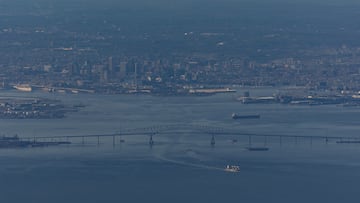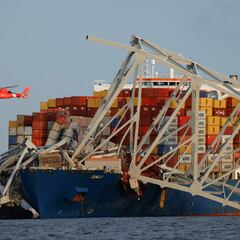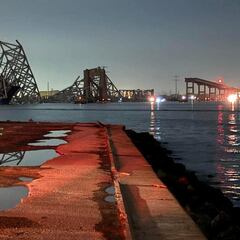What is the Baltimore Key Bridge made of and how much does it weigh?
The steel structure served as a crucial passage for both vehicle and maritime traffic for nearly five decades before its destruction.


The Francis Scott Key Bridge, a Baltimore icon for nearly 50 years, has tragically collapsed after a ship collision.
Classified as a steel arch-shaped continuous through truss bridge, the Key Bridge wasn’t just a simple steel structure. Its main span was a continuous truss; a series of triangular steel frames acting together to bear immense weight. The weight of the bridge itself is not known.
What is a continuous truss?
A continuous truss is a type of truss bridge that extends without hinges or joints across three or more supports. This design allows them to distribute weight from traffic more efficiently than a series of simple trusses. In a series of simple trusses, each individual truss needs to be strong enough to support the entire load on its own.
This design offered impressive strength without sacrificing aesthetics, thanks to the arch incorporated into the design.
The monumental size of the bridge
Spanning a total of 8,636 feet (2,632 meters), it connected Baltimore’s bustling harbor with the industrial south side. The bridge structure itself was 1.6 miles long with the main span measuring a 1,200 feet (366 meters). At the time of construction in 1977, this made it the world’s third-longest continuous truss bridge. J.E. Greiner Co., Inc. of Baltimore designed the project.
A portion of the Francis Scott Key Bridge in Baltimore has collapsed after a ship struck it early Tuesday morning, sending multiple vehicles into the water https://t.co/4DSicCuyLw pic.twitter.com/FqMkHMil0I
— Bloomberg (@business) March 26, 2024
While the strength of steel played a dominant role, the bridge wasn’t solely reliant on it. The design incorporated a clever combination of elements for optimal stability and functionality:
Related stories

Who was Francis Scott Key?

What ship caused the Baltimore Key Bridge to collapse?
Including the aforementioned continuous truss, the bridge had a central structure called a cantilever. These sections helped distribute the weight of the bridge more evenly and extend its reach across the water.
The slight arching of the main span wasn’t just for aesthetics. It offered additional support, helping the bridge bear its own weight and resist downward forces.